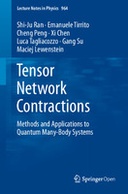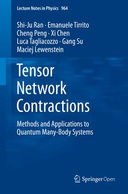Explore

Tensor Network Contractions: Methods and Applications to Quantum Many-Body Systems
Tensor network is a fundamental mathematical tool with a huge range of applications in physics, such as condensed matter physics, statistic physics, high energy physics, and quantum information sciences. This open access book aims to explain the tensor network contraction approaches in a systematic way, from the basic definitions to the important applications. This book is also useful to those who apply tensor networks in areas beyond physics, such as machine learning and the big-data analysis.
Tensor network originates from the numerical renormalization group approach proposed by K. G. Wilson in 1975. Through a rapid development in the last two decades, tensor network has become a powerful numerical tool that can efficiently simulate a wide range of scientific problems, with particular success in quantum many-body physics. Varieties of tensor network algorithms have been proposed for different problems. However, the connections among different algorithms are not well discussed or reviewed. To fill this gap, this book explains the fundamental concepts and basic ideas that connect and/or unify different strategies of the tensor network contraction algorithms. In addition, some of the recent progresses in dealing with tensor decomposition techniques and quantum simulations are also represented in this book to help the readers to better understand tensor network.
This open access book is intended for graduated students, but can also be used as a professional book for researchers in the related fields. To understand most of the contents in the book, only basic knowledge of quantum mechanics and linear algebra is required. In order to fully understand some advanced parts, the reader will need to be familiar with notion of condensed matter physics and quantum information, that however are not necessary to understand the main parts of the book. This book is a good source for non-specialists on quantum physics to understand tensor network algorithms and the related mathematics.
This book is included in DOAB.
Why read this book? Have your say.
You must be logged in to comment.
Rights Information
Are you the author or publisher of this work? If so, you can claim it as yours by registering as an Unglue.it rights holder.Downloads
- 121 - pdf (CC BY) at OAPEN Library.
- 219 - mobi (CC BY) at Unglue.it.
- 235 - pdf (CC BY) at Unglue.it.
- 248 - epub (CC BY) at Unglue.it.
Keywords
- artificial intelligence
- Computer science
- Computing & information technology
- Elementary particles (Physics)
- Machine learning
- Mathematical physics
- Mathematics & science
- multi-linear algebra
- Open Access Book
- Optical Physics
- Physics
- quantum circuits
- quantum entanglement
- Quantum field theory
- Quantum optics
- Quantum Physics
- Quantum physics (quantum mechanics & quantum field theory)
- quantum simulations in many-body systems
- Renormalization group
- Statistical physics
- strongly-correlated systems
- tensor decompositions
- thema EDItEUR::P Mathematics and Science::PH Physics::PHJ Optical physics
- thema EDItEUR::P Mathematics and Science::PH Physics::PHQ Quantum physics (quantum mechanics and quantum field theory)
- thema EDItEUR::P Mathematics and Science::PH Physics::PHS Statistical physics
- thema EDItEUR::P Mathematics and Science::PH Physics::PHU Mathematical physics
- thema EDItEUR::U Computing and Information Technology::UY Computer science::UYQ Artificial intelligence::UYQM Machine learning
Links
DOI: 10.1007/978-3-030-34489-4web: https://link.springer.com/book/10.1007/978-3-030-34489-4
Editions


